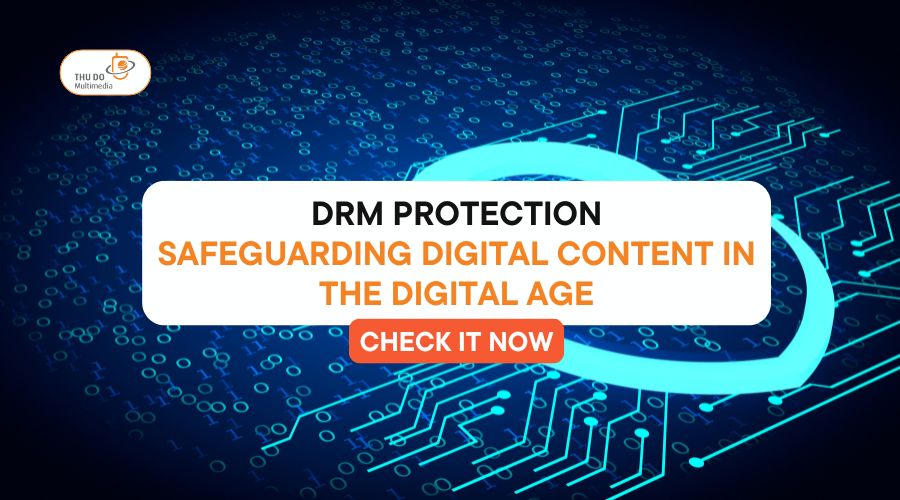In the ever-evolving digital landscape, the protection of digital content has become paramount. Digital Rights Management (DRM) serves as the cornerstone of this endeavor, offering a suite of technologies and strategies to safeguard digital assets from piracy and unauthorized access. This article delves into the intricacies of DRM protection, exploring its definition, significance, technologies, applications, challenges, and benefits. From encryption to access control, licensing to enforcement mechanisms, understanding DRM is essential for content creators, distributors, and consumers alike.
Understanding DRM Protection Mechanisms
What is DRM solution, why is it important in protecting digital content copyright? Right now we will go and learn about the overview with everyone.
Explanation of DRM Protect Technologies and Techniques
DRM protection encompasses a range of technologies and techniques aimed at controlling access to digital content and managing its distribution. Encryption algorithms like AES and DRM systems are utilized to encrypt digital content, ensuring its confidentiality and integrity. Access control mechanisms, such as authentication protocols and digital certificates, validate user identities and regulate access rights. Digital watermarking techniques embed identifiers into digital content, enabling the tracking of unauthorized copies. These mechanisms work together to fortify the security of digital assets, preventing unauthorized access and distribution.

Application of DRM Protection in Various Industries
DRM protection finds applications across diverse industries, including media, publishing, software, and gaming. In the media industry, DRM enables content creators to control the distribution of their music, movies, and television shows across digital platforms. Publishers leverage DRM to protect e-books and educational materials from piracy, safeguarding their intellectual property rights. Software developers use DRM to prevent software piracy and enforce licensing agreements. Despite challenges like interoperability issues and circumvention tactics, DRM remains essential for preserving the value and integrity of digital assets.
Challenges and Benefits of Implementing DRM Protection Solutions
While DRM offers numerous benefits, its implementation presents challenges. Balancing security with user access and experience is crucial, as overly restrictive measures can hinder legitimate user access. Addressing compatibility issues across devices and platforms requires standardized formats and protocols. Moreover, ethical and legal implications must be considered, ensuring compliance with copyright regulations. Despite these challenges, DRM protection offers benefits such as preventing unauthorized access, safeguarding intellectual property, and ensuring compliance with licensing agreements.
Key Features of DRM Protection Systems
Now that we’ve explored the key features of DRM protection systems, let’s examine the benefits that DRM protection offers in safeguarding digital content and intellectual property.
Encryption and Access Control Measures in DRM Protection
One of the fundamental features of DRM protection systems is encryption, which renders digital content indecipherable to unauthorized users. Advanced encryption algorithms are employed to encode digital content, ensuring its confidentiality and integrity during transmission and storage. Access control measures complement encryption by regulating user access based on predefined permissions. Authentication protocols verify user identities, while digital certificates validate their rights to access protected content. Together, encryption and access control form the backbone of DRM protection systems, fortifying the security of digital assets against unauthorized access and distribution.
Licensing and Usage Restrictions for Protected Content
Another key feature of DRM protection systems is the imposition of licensing and usage restrictions on protected content. Content owners can specify the terms and conditions under which their content can be accessed, copied, and shared. Licensing agreements delineate the rights and responsibilities of both content creators and consumers, outlining permissible uses and prohibited activities. Usage restrictions, such as copy and print limitations, prevent unauthorized reproduction and distribution of protected content. By enforcing licensing and usage restrictions, DRM protection systems empower content owners to monetize their digital assets while maintaining control over how they are consumed and shared.
Monitoring and Enforcement Mechanisms for DRM Protection
Monitoring and enforcement mechanisms play a crucial role in ensuring compliance with DRM protection policies and detecting unauthorized access or usage. DRM systems often incorporate monitoring tools that track user activities and access patterns, generating audit logs and reports for analysis. These monitoring capabilities enable content owners to identify suspicious behavior and potential security breaches, allowing them to take timely remedial action. Enforcement mechanisms, such as digital rights management servers, enforce DRM policies by controlling access to protected content and enforcing usage restrictions. By implementing robust monitoring and enforcement mechanisms, DRM protection systems enhance the accountability and integrity of digital content distribution, deterring piracy and unauthorized usage.
Benefits of DRM Protection
This solution brings many benefits to businesses. Here are some outstanding advantages that DRM solutions possess:
Preventing Unauthorized Access and Distribution of Protected Content
One of the primary benefits of DRM protection is its ability to prevent unauthorized access and distribution of protected content. By encrypting digital content and implementing access control measures, DRM systems restrict access to authorized users only. This prevents unauthorized individuals from accessing or sharing digital content without proper authorization, thereby mitigating the risks of piracy, copyright infringement, and revenue loss. DRM protection ensures that content owners retain control over how their digital assets are accessed and distributed, preserving the integrity and value of their intellectual property.
Safeguarding Intellectual Property and Revenue Streams
DRM protection plays a crucial role in safeguarding intellectual property and revenue streams for content creators, distributors, and rights holders. By enforcing licensing agreements and usage restrictions, DRM systems enable content owners to monetize their digital assets through various distribution channels, such as online platforms, streaming services, and e-commerce storefronts. This ensures that content creators receive fair compensation for their creative endeavors while deterring unauthorized copying, sharing, and distribution of their work. DRM protection safeguards the economic interests of content owners, fostering a sustainable digital ecosystem where creativity and innovation are rewarded.
Ensuring Compliance with Copyright and Licensing Regulations
Another significant benefit of DRM protection is its role in ensuring compliance with copyright and licensing regulations. DRM systems enable content owners to enforce copyright laws and licensing agreements by specifying the terms and conditions under which their digital content can be accessed, copied, and shared. This helps content owners protect their intellectual property rights and uphold legal obligations while providing consumers with transparent and legitimate access to digital content. By promoting adherence to copyright and licensing regulations, DRM protection fosters trust and accountability in the digital marketplace, facilitating fair and ethical practices in content distribution.
Challenges and Considerations in Implementing DRM Protection
We will discuss the challenges and considerations in implementing DRM protection. Let’s explore real-world examples and case studies of DRM protection implementation across various industries.
Balancing Security with User Access and User Experience
One of the primary challenges in implementing DRM protection is striking the right balance between security and user access/user experience. While robust security measures are essential for protecting digital content, overly restrictive DRM policies can hinder legitimate user access and degrade user experience. Complex authentication processes, frequent license validations, and limited device compatibility may frustrate users and drive them towards alternative, less secure distribution channels. Content owners must carefully evaluate the trade-offs between security and usability, ensuring that DRM protection measures are transparent, seamless, and user-friendly to maximize adoption and satisfaction.
Addressing Compatibility Issues Across Devices and Platforms
Another challenge in implementing DRM protection is addressing compatibility issues across devices and platforms. With the proliferation of smartphones, tablets, e-readers, and smart TVs, digital content must be accessible across a wide range of devices and operating systems. However, interoperability issues may arise when attempting to deploy DRM protection solutions across diverse hardware and software environments. Content owners must ensure that their DRM systems support industry-standard formats and protocols, enabling seamless integration with popular devices and platforms. Compatibility testing and ongoing updates are essential to ensure that DRM-protected content remains accessible and functional across evolving digital ecosystems.
Dealing with Ethical and Legal Implications of DRM Implementation
In addition to technical challenges, implementing DRM protection raises ethical and legal considerations that must be carefully addressed. DRM systems may restrict consumers’ rights to access, copy, and share digital content, raising concerns about digital rights and freedoms. Content owners must navigate a complex legal landscape governing copyright, fair use, and consumer protection to ensure that their DRM policies comply with applicable laws and regulations. Transparent communication, user education, and clear terms of service are essential to build trust and mitigate concerns about privacy, data security, and digital rights infringement. Content owners must strike a delicate balance between protecting their intellectual property rights and respecting consumers’ rights and expectations in the digital age.
Case Studies and Examples of DRM Protection Implementation
Currently, many businesses in different fields are applying DRM to protect content copyright on digital platforms, including:
Successful Deployment of DRM Protection in Media Streaming Services
Media streaming services have successfully implemented DRM protection to secure their vast libraries of movies, TV shows, and original content. Platforms like Netflix, Hulu, and Disney+ employ robust DRM systems to encrypt their video streams, enforce licensing agreements, and prevent unauthorized access or distribution. By leveraging DRM protection, these services can offer a seamless and secure streaming experience to subscribers while deterring piracy and copyright infringement. Through content encryption, access control, and monitoring mechanisms, media streaming services uphold the integrity of their digital libraries and safeguard their revenue streams.
DRM Strategies in E-book Publishing Industry
The e-book publishing industry relies heavily on DRM protection to safeguard digital books from piracy and unauthorized distribution. Major e-book retailers like Amazon Kindle and Apple Books utilize DRM technologies to encrypt e-books and enforce usage restrictions, such as limiting the number of devices on which a book can be accessed or preventing copying and sharing. While DRM protection has been criticized for restricting consumers’ rights, it remains a vital tool for publishers to protect their intellectual property and revenue streams. By implementing DRM strategies, e-book publishers can ensure that authors receive fair compensation for their work while providing consumers with secure access to digital books.

Read More: eBook DRM: Protecting Publisher’s Content in the Digital Age
Challenges Faced by Software Developers in DRM Protection
Software developers face unique challenges in implementing DRM protection to prevent software piracy and license misuse. DRM systems must strike a delicate balance between protecting software from unauthorized copying and preserving user flexibility and usability. Complex licensing schemes, activation processes, and software tamper detection mechanisms may introduce friction into the user experience and drive users towards pirated copies or alternative software solutions. Moreover, software developers must contend with sophisticated hacking techniques and circumvention tools that seek to bypass DRM protections and crack software licenses. Despite these challenges, this protection remains essential for software developers to safeguard their intellectual property and revenue streams in an increasingly digital marketplace.
Future Trends and Innovations in DRM Protection
As technology continues to evolve, the landscape of DRM protection is poised for significant advancements and innovations. Several emerging trends are shaping the future of DRM, offering enhanced security, flexibility, and usability for content creators, distributors, and consumers alike.
Emerging Technologies in DRM Solutions
Advancements in encryption algorithms, blockchain technology, and artificial intelligence (AI) are driving innovation in DRM solutions. New encryption algorithms with improved performance and resistance to attacks are enhancing the security of DRM-protected content. Blockchain technology is being explored to create decentralized DRM platforms that offer greater transparency, traceability, and tamper resistance. AI-powered DRM systems can analyze user behavior, detect anomalies, and adapt security measures in real-time to mitigate emerging threats.
Evolution of DRM Policies and Practices
The evolution of DRM policies and practices is influenced by changes in legislation, industry standards, and consumer preferences. Regulatory developments, such as the European Union’s General Data Protection Regulation (GDPR) and the Digital Millennium Copyright Act (DMCA), shape the legal framework governing DRM implementation and enforcement. Industry initiatives, such as the Open Digital Rights Language (ODRL) and the Secure Content Storage Association (SCSA), promote interoperability and standardization in DRM technologies and practices. Consumer demand for seamless and user-friendly DRM solutions drives innovation in usability, accessibility, and transparency.
Predictions for the Future of DRM Protection
Looking ahead, DRM protection is expected to continue evolving in response to evolving threats, technologies, and market dynamics. Predictions for the future of DRM include:
Increased Focus on User-Centric DRM
Future DRM solutions will prioritize user-centric design principles, offering seamless access, flexibility, and personalization while maintaining robust security measures.
Integration with Emerging Technologies: DRM protection will integrate with emerging technologies such as augmented reality (AR), virtual reality (VR), and the Internet of Things (IoT) to secure digital content across diverse platforms and devices.
Enhanced Collaboration and Partnerships
Content creators, distributors, technology providers, and regulatory bodies will collaborate more closely to develop interoperable DRM solutions that meet the needs of all stakeholders while respecting consumers’ rights and privacy.
Continued Battle Against Piracy and Unauthorized Access
Despite advancements in DRM technology, piracy and unauthorized access will remain persistent challenges. DRM solutions will continue to evolve to stay ahead of emerging threats and adapt to changing piracy tactics.
Introducing Sigma Multi DRM to Protect Your Content
As you navigate the complexities of DRM protection and seek robust solutions for safeguarding your digital content, consider Sigma Multi DRM – a solution provided by ThuDo Multimedia. Our comprehensive DRM platform offers cutting-edge encryption, access control, and monitoring mechanisms to protect your content across diverse industries and distribution channels.
With Sigma Multi DRM, you can secure your intellectual property, uphold licensing agreements, and ensure compliance with copyright regulations while delivering a seamless and secure experience for your users. Join the ranks of leading content creators, distributors, and rights holders who trust Sigma Multi DRM to safeguard their digital assets in today’s dynamic digital landscape.
Conclusion
In conclusion, DRM protection is essential for safeguarding digital content in today’s digital landscape. It plays a vital role in preserving intellectual property, enforcing licensing agreements, and ensuring fairness for creators and users. ThuDo Multimedia is at the forefront of providing innovative DRM solutions, empowering stakeholders to navigate digital distribution securely. Contact us to learn more!


Recent Comments